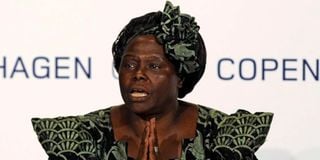Equality and environment: Lessons from Prof Maathai

This file photo taken on December 15, 2009 shows Nobel Peace Prize Laureate, Kenyan professor Wangari Maathai, attending a meeting at the Bella center of Copenhagen on the 9th day of the COP15 UN Climate Change Conference.
What you need to know:
- Women are by far the biggest resource conservers and managers of the natural environment.
- However, decisions about strategy and resource allocation in these arenas are overwhelmingly made by men.
The earth is changing and the knowledge that this is happening in Kenya is spreading far and wide. It’s evident the seasons in Kenya are not what they used to be: rain is too much or too little, sunshine is non-existent or extreme.
People living near rivers, lakes and the sea have much to say too, and Kenyans would do well to listen to farmers, whose very output is sensitive to climate being reliable and tolerant.
The vast majority of farmers in Kenya are smallholder, subsistence farmers, who must somehow rely on what is increasingly unpredictable. According to statistics from Trees for the Future, 42 per cent of Kenyans live below the poverty line. Forty per cent depend on agriculture for a living, and three in 10 are food insecure. This sector needs urgent high-level interventions for Kenya to have any hope.
We looked to our own Nobel Peace Prize Laureate, the late, great Prof Wangari Maathai, for inspiration and one of her most memorable rallying calls is that we can each do one little thing to contribute to the betterment of all.
However, to have an expectation of halting and reversing the damage done to the earth, any engagements must go higher and further than individual efforts. The sheer size of the Dandora dump site, for instance, needs constant, repeated policy and regulation to continue to exist. When people see that nothing is being done, and no alternative methods for waste disposal are fronted, the cycle tragically continues uninterrupted.
Push for the earth to heal
From the life and actions of Prof Maathai, we learn that environmental conservation will never be successful without full involvement of women. Women are by far the biggest resource conservers and managers of the natural environment, which they interact with while caring for farms, finding sources of water, fuel and food for their families.
However, decisions about strategy and resource allocation in these arenas are overwhelmingly made by men. Prof Maathai’s work shows us that a push for women’s human rights is tied irreversibly to the push for the earth to heal: these things are not divisible – in practice, they are the same thing.
Secondly, community is and will always be a collective effort. We should all act together to make changes. Third, we must consider that community never happens automatically. It must be organised.
New members must be recruited, old ones kept, and active, constant participation as part of ongoing growth and administration must happen. Effort and time must be put into these matters, and members must get and stay engaged.
Prof Maathai’s legacy is her deeds. It is also in us, as the people who will carry forward her light, in taking bigger, braver steps together, ensuring full inclusion of women, and in caring for and protecting the earth in all the ways it deserves.
The writer is a policy analyst. [email protected]





